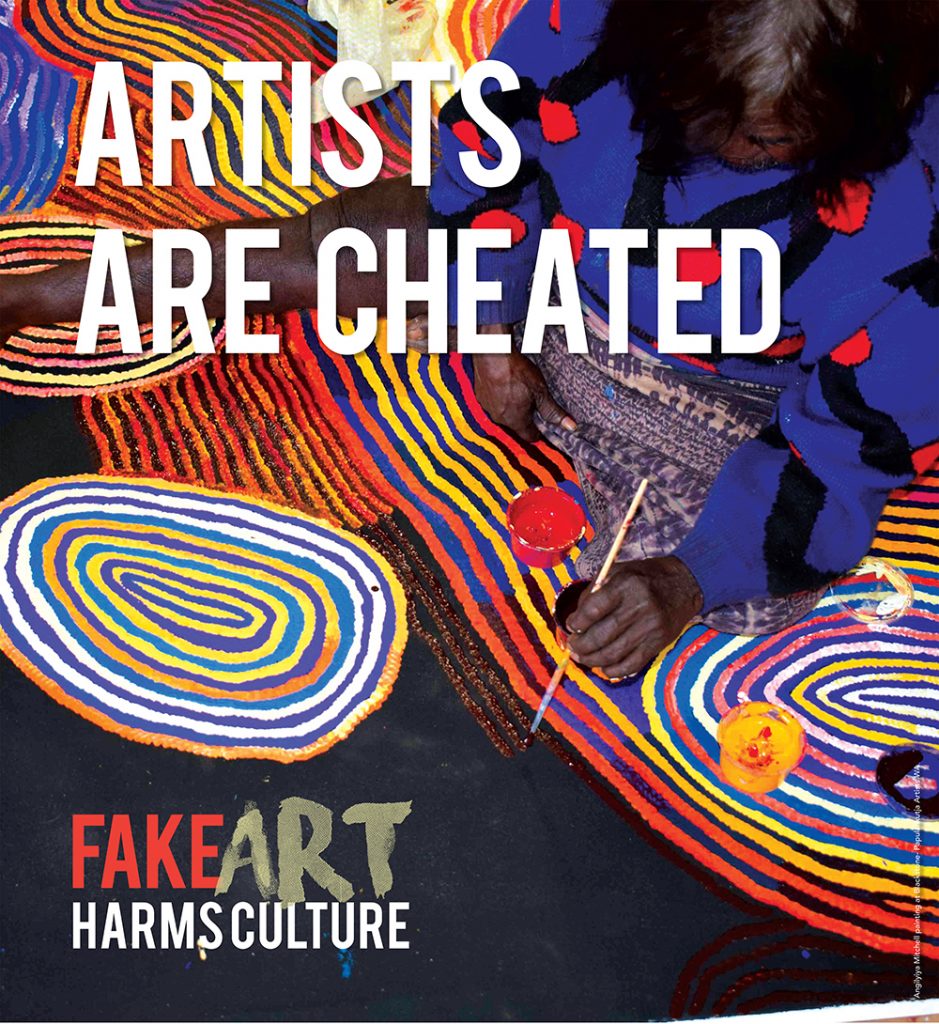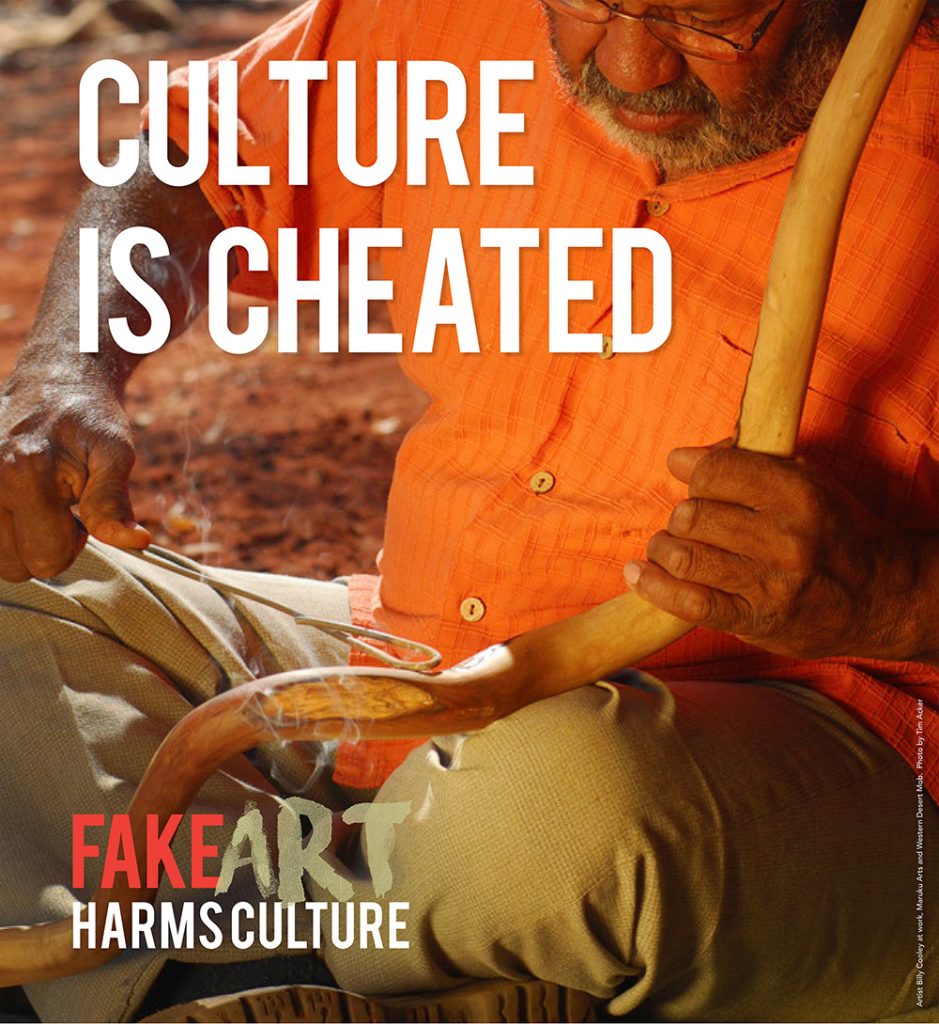Fake Art Harms Culture
The Fake Art Harms Culture campaign was created to address the concern of widespread sale of works that have the ‘look and feel’ of being Indigenous but actually have no connection to Aboriginal and Torres Strait Islander communities.
Get involved in the #FAHC campaign
How does fake art harm culture?
We estimate that around 80% of the products available in shops is inauthentic. The abundance of fake or inauthentic ‘Aboriginal-style’ arts and crafts available in Australian tourism shops causes harm to Aboriginal and Torres Strait Islander peoples as it misappropriates and exploits the stories, imagery, knowledge and heritage embodied in authentic works. In short, fake art harms culture.
It also destroys the income streams that could be earned from selling genuine arts and craft works to the many consumers wanting to connect with Indigenous Australia. Our work on the campaign also highlights the exploitation and misuse of Indigenous culture through what Aboriginal and Torres Strait Island artists call ‘fake deals’, where there is an authentic connection between the art and the consumer goods produced, but the arrangement with the artist is exploitative.
Fake Art means artists are cheated, buyers are cheated and Australia as a country is cheated.
Read news about the campaign
Find out more about our advocacy
About the campaign
In 2016, Arts Law Centre, the Indigenous Art Code and the Copyright Agency began to explore how to best respond to concerns about the growing presence of inauthentic ‘Aboriginal style’ art and craft products and merchandise for sale across Australia. A mystery shopping exercise in tourist locations in various capital cities found very large numbers of inauthentic items and estimates suggest this is a multi-million dollar industry. These are commercially produced goods, generally aimed at the tourist market; often made from non-traditional materials; and featuring inauthentic and culturally inappropriate designs. They range from bamboo didgeridoos, to decorative plates and key rings.
The Fake Art Harms Culture campaign is calling on the Government to tackle the problem of fake ‘Indigenous’ arts and craft being sold in Australia.
Read our latest submissions
2016
- Arts Law Centre of Australia, Indigenous Art Code and Copyright Agency launched Fake Art Harms Culture campaign at Darwin Aboriginal Art Fair.
2017
- Senator Bob Katter twice introduced the Private Members Bill into Parliament, which sought to amend the Australian Consumer Law by preventing non- Aboriginal and Torres Strait Islander persons from benefitting from the sale of Aboriginal and Torres Strait Islander art and souvenirs.
- Almost 1000 post cards sent to then Prime Minister Malcolm Turnbull.
- Minister for Indigenous Affairs, Senator Nigel Scullion referred an inquiry to the House of Representatives Standing Committee on Indigenous Affairs, about the growing presence of inauthentic Aboriginal and Torres Strait Islander ‘style’ art and craft products and merchandise for sale across Australia.
- The Arts Law Centre of Australia made a submission to the House of Reps Standing Committee on Indigenous Affairs Inquiry along with 161 other organisations and individuals.
2017-2019
- The House of Reps Standing Committee on Indigenous Affairs conducted the Inquiry, and the Report on the impact of inauthentic art and craft in the style of First Nations peoples was tabled in December 2018.
- The Fake Art Harms Culture campaign gains significant media coverage, including a 60 Minutes investigation.
2018
- The Australian Competition and Consumer Commission (ACCC) commenced legal proceedings against Birubi Art, a souvenir manufacturer, for misleading consumers into purchasing fake Aboriginal art products.
2019
- In June, the Federal Court found that Birubi Art had falsely claimed that products it sold were hand painted by Australian Aboriginal persons and made in Australia when that was not true. The Federal Court ordered Birubi to pay a $2.3 million penalty.
- Senator Hanson-Young introduced the Competition and Consumer Amendment (Prevention of Exploitation of Indigenous Cultural Expressions) into Parliament (2019 Bill).
- Roughly 1000 postcards sent to Prime Minister Scott Morrison from the Darwin Aboriginal Art Fair, calling for changes to the law.
- Arts Law, Indigenous Art Code and the Copyright Agency, assisted by solicitor Ted Hill, appeared before the Senate Committee to present an alternate version of legislation, which would deal with secret and sacred objects, and include regulations for licensing authentic Indigenous art for products and merchandise.
2020
- 3 years after the launch of Fake Art Harms Culture campaign we are still waiting for a response from the Government to the House of Representatives report.
- In April the report of Senate’s Environment and Communications Legislation Committee on Competition and Consumer Amendment (Prevention of Exploitation of Indigenous Cultural Expressions) Bill 2019 tabled in Parliament with key recommendation being “that the Commonwealth consult Indigenous artists, organisations and communities to develop legislation to prohibit the sale of inauthentic Indigenous products sold as souvenirs, either through amendment of the Competition and Consumer Act 2010 or through another mechanism.
2022
- The Productivity Commission report into Aboriginal and Torres Strait Islander Visual Arts and Crafts, confirms what we already know… fake art harms culture. Up to 75% Indigenous-style consumer products in the market are fake.
- The commission report has recommended a mandatory labelling scheme for inauthentic products.
- The Commission has also recommended dedicated laws to better protect Indigenous Cultural and Intellectual Property (ICIP) in Indigenous visual arts and crafts as a first step.
The Fake Art Harms Culture campaign continues to advocate for a comprehensive legislative strategy to protect all aspects of ICIP, the ban of inauthentic product and increased access to legal services for Aboriginal and Torres Strait Islander artists.